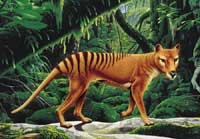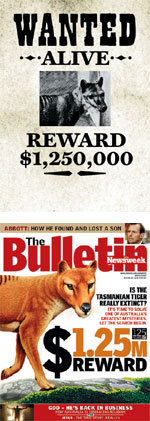 Image.
Image. The
Tasmanian tiger. © Photo Copyright.
The Bulletin magazine - Australia. Website:
Bulletin.
For they who want to claim the magazine's reward had to report it before the
30 June 2005.
As the magazine's editor-in-chief, Garry Linnell writes on
Bulletin`s website (Bulletin.ninemsn.com.au/tiger):
"Is the Tasmanian tiger really extinct? We know the myth is out there. But
what about the truth? Over the past 70 years more than 4000 alleged sightings of
the believed-to-be-extinct Tasmanian tiger have been reported. Yet not one solid
shred of evidence - not a bone, a hair, much less a body - has ever been put
forward to prove that the thylacine is the greatest escape artist in the animal
kingdom".
The Bulletin offer was an attempt to solve what it called "one of Australia's
most enduring mysteries". Mr Linnell hoped that the thylacine had survived in
the Tasmanian wilderness, despite being declared extinct in 1986. Even with more
than 4000 unconfirmed sightings of thylacines since the last tiger died in
captivity in Hobart Zoo in the island's capital in 1936, didn`t bring any
evidences.
|
Image. Annoncement and front page from the
Bulletin magazine.
©
Photo Copyright Bulletin
.
After dramatic claims by a German tourist to have seen one of the
mysterious, meat-eating marsupials lurking deep in the Tasmanian
wilderness, Australian magazines and travel companies are offering a
combined bounty of $A3 million (£1.2 million) to anybody who can capture
what was long supposed to be an extinct creature.
A newspaper has also been offered photos of the Tasmanian Tiger, but
according to reports it has not been able to verify that the striped
animal in the pictures was genuinely a Tasmanian
tiger. Even with assistance from zoologists and photographic
specialists the newspaper couldn`t be sure. |
 |
A magazine has offered $A 1.25 million (£500,000) for the capture of a live
animal, and an adventure travel company topped that with an offer of a further
$A1.75 million (£700,000).
The Tasmanian tiger, or Thylacinus cynocephalus, was an elongated dog -
measuring six foot from nose to tail tip - with brown-black stripes, a heavy,
stiff tail and a big head, which led to it also being known as the Tasmanian
wolf.
It was targeted for hunting because settlers believed it was inflicting
damage on their sheep, and at one point the state government offered a bounty
for each tiger killed. Now it has started a new hunt, but for other intentions.
Even the deadline for getting the bounty is exceeded, the big manhunt will
continue. The myth about this animal will live!
Stein Morten Lund, 31 August 2005
Additional information
Link to the article about the Tasmanian tiger in the
Bulletin - Australia: Bulletin.ninemsn.com.au/tiger.
The Bulletin Magazine - Australia. Website: Bulletin.
The Columbia Encyclopedia, Sixth Edition; 6/7/2005:
THYLACINE [thylacine] or Tasmanian wolf,
carnivorous marsupial , or pouched mammal, of Tasmania. The thylacine is often
cited as an example of convergent evolution: It is superficially quite similar
to a wolf or dog, although it has evolved entirely independently of these
animals.
About the size of a collie, it has a long tail and a wolflike head with short
ears and strong jaws and teeth. Its coat is brownish with a series of black
stripes across the back; it is also known as the Tasmanian tiger. A nocturnal
hunter, the thylacine preys on animals up to the size of small kangaroos.
The female gives birth to very undeveloped young, which
are then carried in a pouch surrounding the teats. Thylacines have been hunted
nearly to extinction because of their attacks on sheep and poultry. The last
thylacine in captivity died in the Hobart Zoo in 1936, but a few individuals are
believed to survive in wild areas of W Tasmania. They are classified in the
phylum Chordata , subphylum Vertebrata, class Mammalia, order Marsupialia,
family Dasyuridae.
